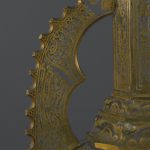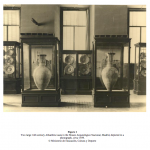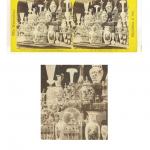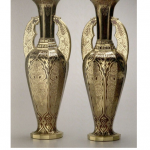9935 A MONUMENTAL CUT GLASS AND GILDED VASE OF ALHAMBRA FORM EXHIBITED BY WILHELM HOFFMAN AT THE 1862 LONDON INTERNATIONAL EXHIBITION Bohemia. Circa 1860. Measurements: Height: 41 1/2″ (105 cm) Width: 11 1/2″ (29 cm)

-
Figure 1
-
Figure 2
-
Figure 3
-
Figure 4
Research
This exceptionally fine and monumental glass vase was exhibited by Herr Wilhelm Hoffmann of Prague at the 1862 London International Exhibition.
It is a 19th-century variation on the “Alhambra Vases” of the 14th and 15th centuries. These Hispano-Moresque wares derived from ancient amphoras and were made for purely decorative purposes to stand in niches probably at the Alhambra in Grenada, to which they owe their name. The original vases, only eight of which survive intact, are impressive in decoration and size (the largest being over 5 feet in height) with a swelling body and large, flat wing-like handle. Figure 1 depicts two large examples of Alhambra vases in the Museo Arqueológico Nacional, Madrid, in a photograph circa 1936. It is interesting to note that in the present vase, in line with the 19th century fondness for eclecticism, the overall “Arabic” form is combined with some decorative elements selected from the Chinese canon of ornament.
Islamic art had been attractive to Europeans at least since the Renaissance and reached a new level of admiration in the 19th century with the rediscovery of Moorish Spain. In 1834 Owen Jones, along with Jules Goury, embarked on a study of the decoration of the Alhambra palace, which Jones completed in 1837 and which depicted an Alhambra vase entitled “La Jarra.” It was in the 1850s that “the Alhambra vases came to be known as embodiment of the beauty of Spanish art. It was in this period too that the large vases with their wing-like handles became important examples for pottery producing companies.”1
Alhambra vases were reproduced in various sizes using numerous pottery techniques. This extended to metal, glasswork, and porcelain as well. The Sèvres factory produced two pairs of porcelain vases of Alhambra form, with decoration very close to that on a vase at the Alhambra Palace. One pair, dated 1852, is housed in the Mobilier National, Paris (Inv. GMI.10124/2) while the other, dated 1843-44, was sold at Christie’s New York, 7 June 2012, Lot 52. Despite the number of different models, the vases all shared the common elements of amphora-shaped bodies and large winged handles. The decoration comprises floral, geometric and abstract patterns, much like the Moorish tile decorations in Owen Jones’ illustrations.
In Bohemia, the 19th century was a period of great advancement in decorative glass production. New manufacturing techniques making for brilliantly colored glass were developed, as were a variety of new shapes and improvements in decoration methods such as cutting, engraving, enameling and ceramic “incrustations.”2
The present vase was illustrated in J.B. Waring’s “Masterpieces of Industrial Art and Sculpture from the International Exhibition of 1862” (Vol. II, Plate No. 125) (figure 2), labeled as an Austrian ornamental vase by Herr W. Hoffmann. Wilhelm Wenzel Sebastian Hoffmann, born in 1808 in Karlsbad (Karlovy Vary, Czech Republic), was a nephew of the famous glassmaker Johann Meyr of Adolfhütte, Bohemia. As of 1837 Hoffmann was a citizen of Prague, where he worked as a glass refiner and retailer. Some time after 1850, he took over the Prague outpost of the famed Harrach Glassworks, which was situated in Neuwelt, in the town of Harrachov, northern Bohemia. Here, Hoffmann traded glass that was made in Neuwelt, cut in his own shop and enameled by the workshop of his brother Karl Hoffmann in Karlsbad. The Harrach glass factory is the oldest working glasshouse in Europe, opened by Count Harrach in 1712. By the mid-1850s Harrach employed approximately 320-350 workers, and their annual output was a staggering 572,000 pounds of finished products, which were decorated in at least 200 refining shops.3
Wilhelm Hoffmann is described in the catalog for the Austrian section of the 1862 Exhibition as a “Patented Glass Refiner and Trader to the Imperial Royal Court, Prague and Vienna.”4 He received honorable mention at the London Great Exhibition of 1851 and an honorary medal at the Munich Industrial Exhibition of 1854, and participated in the Paris Exhibition of 1867 and in Vienna in 1873, where he received further acclaim and awards.5 “All articles of [his] establishment are made, according to [his] own designs, in the glass-houses and then refined by cutting, polishing, painting, gilding or silvering. That manufactory works for inland trade and export, also undertaking works and orders after designs and models sent in.”6 Figure 3 depicts a photograph of Hoffmann’s table at the 1862 Exhibition, by the London Stereoscopic and Photographic Company, with the present vase standing in the center.
The Alhambra shape and arabesque-eclectic design of the present vase was reproduced with variations in size and color by Harrach, Hoffmann and various glass refiners in the mid-19th century. A pair of gilded Alhambra-form vases in the Glasmuseum Passau, circa 1850, although smaller and without the base, is decorated with near-identical arabesque designs as the present vase (figure 4). Petr Novosad, director of the Harrach Glassworks (called the Novosad & Son Glassworks today), suggests that the body of the present monumental vase was most probably made in Harrachov, while the handles and decorations were made in Vienna. Unfortunately, the design book that could prove this was lost during a fire that almost destroyed the glass factory in December of 1862.
Footnotes:
1. Hagedorn, Annette. The Phenomenon Of “Foreign” in Oriental Art. Wiesbaden: Reichert, 2006. 173.
2. Czechoslovakian Glass, 1350-1980. Corning, N.Y: Corning Museum of Glass, 1981. Print. 34.
3. http://www.glasscollector.net/ProjectHarrach/ProjectHarrachIntroduction.html
4. Arenstein, Prof. Dr. Jos. Austria at the International Exhibition of 1862 Upon Orders from the I. R. Ministry of Commerce and National Economy. Vienna: I.R. Court and State Printing Office. 1862. 107.
5. Pazaurek, Gustav E. Gläser Der Empire Und Biedermeierzeit. Leipzig: Klinkhardt & Biermann, 1923. 387, footnote 261.
6. Arenstein, 107.







Comments are closed.